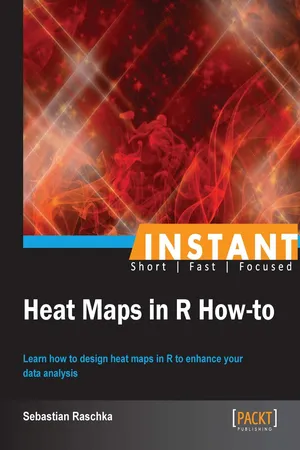![]()
Instant Heat Maps in R How-to
![]()
Instant Heat Maps in R How-to
Copyright © 2013 Packt Publishing
All rights reserved. No part of this book may be reproduced, stored in a retrieval system, or transmitted in any form or by any means, without the prior written permission of the publisher, except in the case of brief quotations embedded in critical articles or reviews.
Every effort has been made in the preparation of this book to ensure the accuracy of the information presented. However, the information contained in this book is sold without warranty, either express or implied. Neither the author, nor Packt Publishing, and its dealers and distributors will be held liable for any damages caused or alleged to be caused directly or indirectly by this book.
Packt Publishing has endeavored to provide trademark information about all of the companies and products mentioned in this book by the appropriate use of capitals. However, Packt Publishing cannot guarantee the accuracy of this information.
First published: June 2013
Production Reference: 1180613
Published by Packt Publishing Ltd.
Livery Place
35 Livery Street
Birmingham B3 2PB, UK.
ISBN 978-1-78216-564-4
www.packtpub.com
![]()
Author
Sebastian Raschka
Reviewers
John B. Johnston
Kristopher Opron
Acquisition Editor
Martin Bell
Commissioning Editor
Yogesh Dalvi
Technical Editor
Ankita R. Meshram
Project Coordinator
Akash Poojary
Proofreader
Paul Hindle
Production Coordinator
Nitesh Thakur
Cover Work
Nitesh Thakur
Cover Image
Aditi Gajjar
![]()
Sebastian Raschka is a PhD student at Michigan State University and is pursuing a doctorate in Biochemistry and Computer Science. He works in the field of protein structure modeling and is focused on the specificity of protein-ligand interactions. His research involves the development of a protein-ligand docking software based on a novel approach, where he combines the fields of machine learning, pattern recognition, and data mining.
In his free time, Sebastian works on web development and uses JavaScript among other technologies to develop web applications that are used by Bioinformaticians and Computational Biologists.
![]()
John Johnston is the Bioinformatics Domain Specialist for the Institute for Cyber-enabled Research at Michigan State University. He specializes in scientific analysis in a high-performance computing environment, and the development of software for the interpretation of biological data. He is an experienced Linux systems administrator and scientific consultant. He previously worked for 18 years as a Senior Groundwater Scientist for several prominent engineering firms, where he specialized in the delineation and mitigation of environmental contamination and site restoration.
Kristopher Opron is a PhD student at Michigan State University studying Computational and Mathematical Biology. For his undergraduate research, he worked under Professor Zachary Burton on molecular dynamics simulations of RNA polymerase II. He is currently working on the development of new computational tools for scientists under Professor Guowei Wei.
![]()
Support files, eBooks, discount offers and more
You might want to visit www.PacktPub.com for support files and downloads related to your book.
Did you know that Packt offers eBook versions of every book published, with PDF and ePub files available? You can upgrade to the eBook version at
www.PacktPub.com and as a print book customer, you are entitled to a discount on the eBook copy. Get in touch with us at
<[email protected]> for more details.
At www.PacktPub.com, you can also read a collection of free technical articles, sign up for a range of free newsletters and receive exclusive discounts and offers on Packt books and eBooks.
http://PacktLib.PacktPub.com
Do you need instant solutions to your IT questions? PacktLib is Packt’s online digital book library. Here, you can access, read and search across Packt’s entire library of books.
- Fully searchable across every book published by Packt
- Copy and paste, print and bookmark content
- On demand and accessible via web browser
Free Access for Packt account holders
If you have an account with Packt at www.PacktPub.com, you can use this to access PacktLib today and view nine entirely free books. Simply use your login credentials for immediate access.
![]()
This book is about the construction of heat maps using the popular statistical programming language R. Heat maps are valuable tools for exploratory data analyses in many different applications, such as gene expression levels or stock market data. Together with powerful clustering methods, heat maps are being used to visually detect interesting patterns at one glance, even in very large data sets with hundreds of variables.
This book is a hands-on guide to provide you with a practical approach to construct such powerful heat maps. You will explore the advanced features of heat maps step-by-step, and detailed explanations on the underlying code at the end of each recipe will provide you with enough information to frame those heat maps as per your needs.
Creating your first heat map in R (Simple) will help you create your first heat maps from a small data set provided in R. You will use different heat map functions in R to get a first impression of their functionalities.
Reading data from different file formats (Intermediate) will help you learn how to read data from various popular file formats. After you have created your first heat maps, it is important to learn how to get your own data into R using differently formatted datasets.
Customizing heat maps (Intermediate) will help you explore more advanced functions to customize the layout of the heat maps. The main focus lies on the usage of different color palettes, but we will also cover other useful features, such as cell notes that will be used in this recipe.
Drawing choropleth maps and contour plots (Intermediate) will help you learn to create choropleth maps of the United States and other countries. Choropleth maps are a great way to visualize data from different regions on a geographical map. Also, you will learn how to visualize a 3D surface using a contour plot.
Exporting for presentation (Simple) will help you export heat maps in various popular image formats. By comparing images with different resolutions and file sizes, you will learn how to find the best-suited format for presenti...

